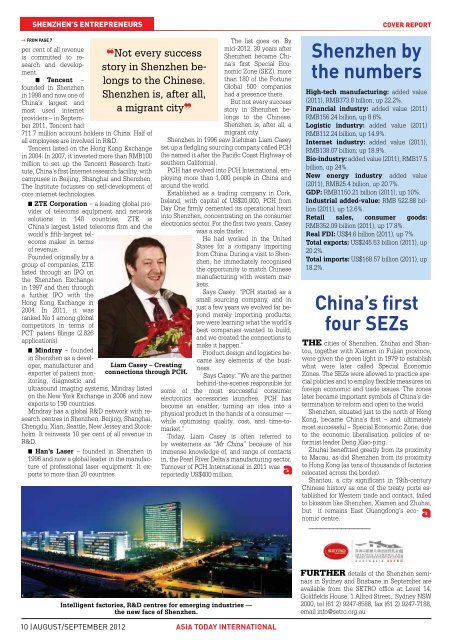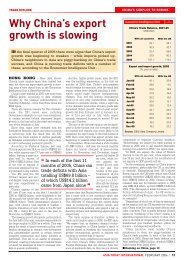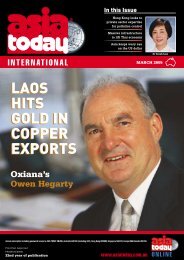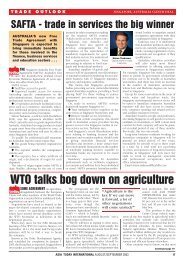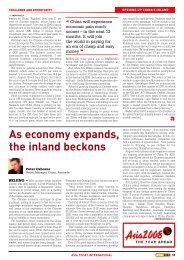download - Asia Today International
download - Asia Today International
download - Asia Today International
You also want an ePaper? Increase the reach of your titles
YUMPU automatically turns print PDFs into web optimized ePapers that Google loves.
SHENZHEN’S ENTREPRENEURS<br />
g FROM PAGE 7<br />
per cent of all revenue<br />
is committed to research<br />
and development.<br />
n Tencent –<br />
founded in Shenzhen<br />
in 1998 and now one of<br />
China’s largest and<br />
most used internet<br />
providers – in September<br />
2011, Tencent had<br />
711.7 million account holders in China. Half of<br />
all employees are involved in R&D.<br />
Tencent listed on the Hong Kong Exchange<br />
in 2004. In 2007, it invested more than RMB100<br />
million to set up the Tencent Research Institute,<br />
China’s first Internet research facility, with<br />
campuses in Beijing, Shanghai and Shenzhen.<br />
The Institute focusses on self-development of<br />
core internet technologies.<br />
n ZTE Corporation – a leading global provider<br />
of telecoms equipment and network<br />
solutions in 140 countries, ZTE is<br />
China’s largest listed telecoms firm and the<br />
world’s fifth-largest telecoms<br />
maker in terms<br />
of revenue.<br />
Founded originally by a<br />
group of companies, ZTE<br />
listed through an IPO on<br />
the Shenzhen Exchange<br />
in 1997 and then through<br />
a further IPO with the<br />
Hong Kong Exchange in<br />
2004. In 2011, it was<br />
ranked No 1 among global<br />
competitors in terms of<br />
PCT patent filings (2,826<br />
applications).<br />
n Mindray – founded<br />
in Shenzhen as a developer,<br />
manufacturer and<br />
exporter of patient monitoring,<br />
diagnostic and<br />
ultrasound imaging systems, Mindray listed<br />
on the New York Exchange in 2006 and now<br />
exports to 190 countries.<br />
Mindray has a global R&D network with research<br />
centres in Shenzhen, Beijing, Shanghai,<br />
Chengdu, Xian, Seattle, New Jersey and Stockholm.<br />
It reinvests 10 per cent of all revenue in<br />
R&D.<br />
n Han’s Laser – founded in Shenzhen in<br />
1996 and now a global leader in the manufacture<br />
of professional laser equipment. It exports<br />
to more than 20 countries.<br />
}Not every success<br />
story in Shenzhen belongs<br />
to the Chinese.<br />
Shenzhen is, after all,<br />
a migrant city~<br />
Liam Casey – Creating<br />
connections through PCH.<br />
The list goes on. By<br />
mid-2012, 30 years after<br />
Shenzhen became China’s<br />
first Special Economic<br />
Zone (SEZ), more<br />
than 180 of the Fortune<br />
Global 500 companies<br />
had a presence there.<br />
But not every success<br />
story in Shenzhen belongs<br />
to the Chinese.<br />
Shenzhen is, after all, a<br />
migrant city.<br />
Shenzhen in 1996 saw Irishman Liam Casey<br />
set up a fledgling sourcing company called PCH<br />
(he named it after the Pacific Coast Highway of<br />
southern California).<br />
PCH has evolved into PCH <strong>International</strong>, employing<br />
more than 1,000 people in China and<br />
around the world.<br />
Established as a trading company in Cork,<br />
Ireland, with capital of US$20,000, PCH from<br />
Day One firmly cemented its operational heart<br />
into Shenzhen, concentrating on the consumer<br />
electronics sector. For the first two years, Casey<br />
was a sole trader.<br />
He had worked in the United<br />
States for a company importing<br />
from China. During a visit to Shenzhen,<br />
he immediately recognised<br />
the opportunity to match Chinese<br />
manufacturing with western markets.<br />
Says Casey: “PCH started as a<br />
small sourcing company, and in<br />
just a few years we evolved far beyond<br />
merely importing products:<br />
we were learning what the world’s<br />
best companies wanted to build,<br />
and we created the connections to<br />
make it happen.”<br />
Product design and logistics became<br />
key elements of the business.<br />
Says Casey: “We are the partner<br />
behind-the-scenes responsible for<br />
some of the most successful consumer<br />
electronics accessories launches. PCH has<br />
become an enabler, turning an idea into a<br />
physical product in the hands of a consumer —<br />
while optimising quality, cost, and time-tomarket.”<br />
<strong>Today</strong>, Liam Casey is often referred to<br />
by westerners as “Mr China” because of his<br />
immense knowledge of, and range of contacts<br />
in, the Pearl River Delta’s manufacturing sector.<br />
Turnover of PCH <strong>International</strong> in 2011 was<br />
reportedly US$400 million.<br />
COVER REPORT<br />
Shenzhen by<br />
the numbers<br />
High-tech manufacturing: added value<br />
(2011), RMB373.8 billion, up 22.2%.<br />
Financial industry: added value (2011)<br />
RMB156.24 billion, up 8.6%.<br />
Logistic industry: added value (2011)<br />
RMB112.24 billion, up 14.9%.<br />
Internet industry: added value (2011),<br />
RMB138.07 billion; up 18.9%.<br />
Bio-industry: added value (2011), RMB17.5<br />
billion, up 24%.<br />
New energy industry: added value<br />
(2011), RMB25.4 billion, up 20.7%.<br />
GDP: RMB1150.21 billion (2011), up 10%.<br />
Industrial added-value: RMB 522.88 billion<br />
(2011), up 12.6%.<br />
Retail sales, consumer goods:<br />
RMB352.09 billion (2011), up 17.8%.<br />
Real FDI: US$4.6 billion (2011), up 7%.<br />
Total exports: US$245.53 billion (2011), up<br />
20.2%.<br />
Total imports: US$168.57 billion (2011), up<br />
18.2%.<br />
China’s first<br />
four SEZs<br />
THE cities of Shenzhen, Zhuhai and Shantou,<br />
together with Xiamen in Fujian province,<br />
were given the green light in 1979 to establish<br />
what were later called Special Economic<br />
Zones. The SEZs were allowed to practice special<br />
policies and to employ flexible measures on<br />
foreign economic and trade issues. The zones<br />
later became important symbols of China’s determination<br />
to reform and open to the world.<br />
Shenzhen, situated just to the north of Hong<br />
Kong, became China’s first – and ultimately<br />
most successful – Special Economic Zone, due<br />
to the economic liberalisation policies of reformist<br />
leader Deng Xiao-ping.<br />
Zhuhai benefitted greatly from its proximity<br />
to Macau, as did Shenzhen from its proximity<br />
to Hong Kong (as tens of thousands of factories<br />
relocated across the border).<br />
Shantou, a city significant in 19th-century<br />
Chinese history as one of the treaty ports established<br />
for Western trade and contact, failed<br />
to blossom like Shenzhen, Xiamen and Zhuhai,<br />
but it remains East Guangdong’s economic<br />
centre.<br />
_______________<br />
Intelligent factories, R&D centres for emerging industries —<br />
the new face of Shenzhen.<br />
Further details of the Shenzhen seminars<br />
in Sydney and Brisbane in September are<br />
available from the SETRO office at Level 14,<br />
Goldfields House, 1 Alfred Street,. Sydney NSW<br />
2000, tel (61 2) 9247-8588, fax (61 2) 9247-7188,<br />
email info@setro.org.au<br />
10 | AUGUST/SEPTEMBER 2012 ASIA TODAY INTERNATIONAL


